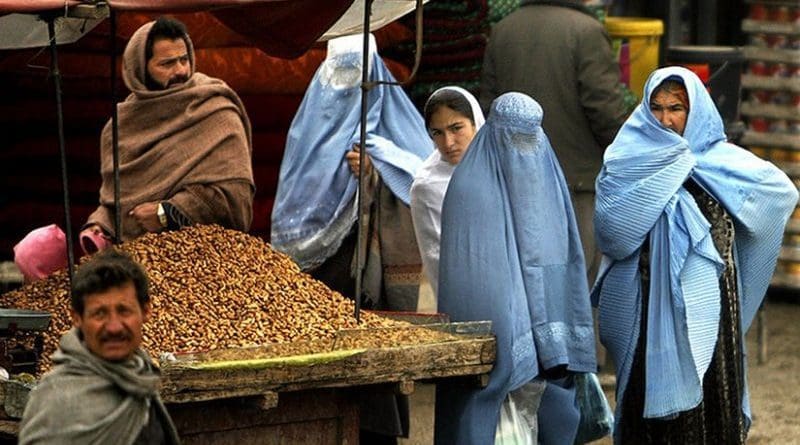Negotiating with the Taliban: Two Steps Backward For Afghanistan Women? – Analysis
By Dr. Shanthie Mariet D Souza
The section of the Afghan society that probably suffered the most during the Taliban regime (1996-2001) in Afghanistan appears to have yet again been marginalized as the pace of the negotiations with the insurgents seem to intensify. Women who were subjected to the worst kind of violence and discrimination under the Taliban regime, again face the stark danger of reversal of gains made thus far, once the reconciliation bid succeeds in bringing back the Taliban to Kabul.
In 2010, the Afghan government established the High Peace Council (HPC), an apex body whose sole function was to provide an official address inside Afghanistan to carry forward the process of reconciliation with the Taliban. The HPC included nine women members. However, since the constitution of the HPC, much of its activities has been undermined by domestic opposition especially the women groups, who loath the return of the Taliban to the power centre of Afghanistan.
The nine women members were former teachers, activists and politicians, each with horror stories about life under Taliban rule. President Hamid Karzai had hoped that the handpicked HPC could help integrate “our Taliban brothers” into a coalition government. Even Western officials maintained that the presence of women is further proof of the representative and inclusive nature of the HPC.
But when the council first met, the nine female members were quickly marginalized. They were not allowed to take part in the initial talks, leaving them exposed to allegations that their presence on the HPC is inconsequential and merely symbolic.
The opinion of women on the talks with the Taliban is yet to be judged. While many women support the idea, they want to hedge it with sufficient preconditions and substantial representation by women in the parliament. For example, Parliamentarian Fauzia Kofi told me last year in Kabul that protection of women rights under a regime where the Taliban has a power sharing arrangement will be an area of serious concern.
In my earlier post “Changing Times for Women in Afghanistan,” I have highlighted the achievements made by women in the last decade. The Taliban rule between 1996 and 2001 with their strict interpretation of the Sharia, alien to a rather moderate Afghan culture, imposed a forceful policy of shutting out women from public life.
Women weren’t allowed to work, to leave their houses or even walk freely, without being subjected to scrutiny by the Taliban’s Ministry of “Ministry for the prevention of vice and promotion of virtue.” Incidents of Taliban lashings of women for infractions such as allowing a glimpse of their ankles to be visible under full-body veils became rather common.
These incidents occur even today, in areas which have come under Taliban control. Video clips on You Tube of women being flogged and shot dead by the Taliban moral police for a variety of transgressions ranging from alleged prostitution, adultery, to acting as informers for the Americans are only a click away.
Such misery notwithstanding, things have started to change. 64 of the 249 seats in Afghanistan’s parliament are currently reserved for women. During the last elections in August 2010, 406 women entered the fray, 78 more than the similar number for the elections in 2005. In the end 69 were chosen as Members of Parliament (MPs), five more than what the reservation would allow.
Other signs of progress include the significant increase in the number of girls and women attending schools and colleges. The number of women working in government offices, army, air forces and police too has increased. The first batch of women officers of Afghan National Army graduated in September 2010. In March 2005, President Hamid Karzai appointed Habiba Sorabi as the governor of central Bamiyan Province. Sorabi was the country’s first ever-female provincial governor. Women now attend Friday prayers in mosques in Kabul. Kabul has a rose park exclusively for women and more beauty parlors, albeit behind thick curtains, have opened.
Along with time, aspirations too have increased. Women activists are no longer content with gender quotas in government and progress on paper. They want to see progress on the streets, in the rulings of the courts and in the behavior of the police. On July 14, women protesters organized under the banner of “Young Women for Change” marched through downtown Kabul in Afghanistan’s first ever public demonstration against sexual harassment.
Concerns, thus, abound that the gains made thus far would be reversed with the advent of the Taliban on the Afghan political landscape. There are no indications to suggest that the Taliban have shifted from their earlier regressive position on women issues.
During the past year, the women of the HPC gained a key ally in the US Secretary of State Hillary Rodham Clinton. Once skeptical of what Taliban negotiations might mean for women’s rights, Secretary Clinton seems to have endorsed the peace process. This has led to doubts and fears among the women groups. In 1997, one of the strong pressure points for the US policy makers to distance from their dealings with the Taliban was the vociferous opposition by women groups in the US coupled with Secretary Madeline Albright’s personal espousal of the cause.
President Karzai has assured that women’s rights would not be sacrificed in the peace process. However, lopsided composition of the HPC and the marginalization of the women members point at a different direction. Afghan women advocacy groups feel that the government is compromising women rights, in a rushed bid to bring peace to the country. By excluding a significant section of the populace who have stake in long-term peace and stability, the entire process could end up being two steps backwards.

